Sharing Dashboards
Dashboard Owners (someone who created a dashboard) and Sisense Administrators can share their dashboards with other Sisense users (Shared Users).
When Dashboard Owners share a dashboard, they can define the level of access the Shared User receives:
- "Designer" access level (dashboard editing rights).
Any changes Shared Users make in the dashboard do not affect your copy of the dashboard. The Shared User's changes are applied to a separate copy of the dashboard to which only they have access. Shared Users can revert to your latest shared copy at any time by right-clicking the dashboard's name in the Dashboards list and selecting Restore Dashboard.

- "Viewer" access level (viewing and filtering rights)
When you share your dashboard, you can configure Sisense to send periodic email notifications containing the dashboard inside the email's body or as a PDF attachment to your dashboard's Shared Users. Alternatively, if you allow them, the Shared Users can configure their own subscription schedules and the delivery method (email or PDF attachment).
When a dashboard is shared, the ![]() icon appears next to the dashboard name in the Dashboards navigation panel:
icon appears next to the dashboard name in the Dashboards navigation panel:

Note:
When you share a dashboard that is contained within a folder, the dashboard is shared using the same structure (under the same folder).
Hover over the dashboard name in the Dashboards list to view ownership details.
Exporting a Dashboard
When you export a dashboard, you download a static copy of the dashboard as a .dash file. You can then send it to others using external tools (such as email or Slack) and they can import the dashboard into their Sisense account.
Exporting your dashboard does not create a link to it. Changes that you make on your dashboard after exporting it are not reflected in the exported dashboard.
To export a dashboard, in the Dashboards list, for the dashboard you want to share, select  > Export .
> Export .
Sharing a Dashboard
When you share a dashboard, you create a link between your dashboard and the shared dashboard. This way, you can
make changes to your dashboard and republish it so that the people you share it with can see your changes.
To share a Dashboard:
- In the heading of your dashboard, click Share
 .
. - Enter the email addresses or groups of users with whom to share the dashboard. Select Everyone to share this dashboard with all Sisense users and user groups.
- The contact information of the people you add is shown in the center of the window and is displayed the next time you open this window.
- If a person does not have a Sisense account, they receive a link that guides them through the activation process.
- In the dropdown menu next to each user and user group, select whether the Shared User will be a Designer (can edit) or a Viewer (can view).
- Toggle the Email Reports
 button next to each user and user group to define
whether the Shared User will receive scheduled email reports of the dashboard. Read more about email reports
below.
button next to each user and user group to define
whether the Shared User will receive scheduled email reports of the dashboard. Read more about email reports
below. - The Dashboard URL field at the bottom displays a direct link to this dashboard that you can copy and paste into an email message, if you like.
- Click Save.
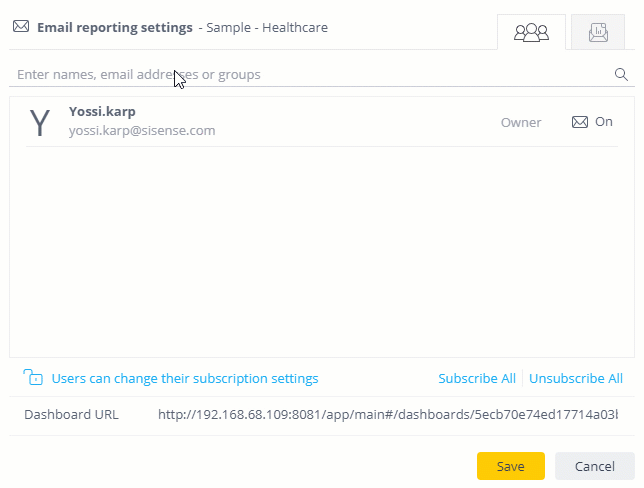
Managing Data Model Permissions When Sharing
If any of the users or groups the dashboard is being shared with do not have access to any of the dashboard's data models, then the Data Source Access Rights modal window is displayed.
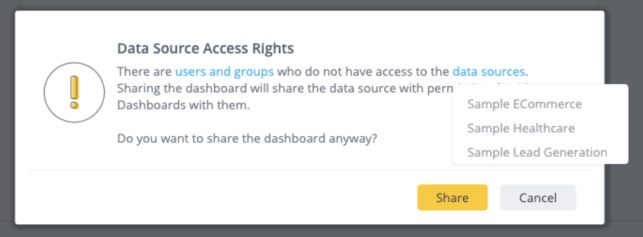
Hovering over the 'users and groups' link displays a full list of all new contributors, and hovering over the 'data sources' link displays a list of all of the data sources to be shared.
For more information about access to data models see Managing Access to Data Models.
Managing Subscriptions
By default, the Dashboard Owner manages the reporting settings (email content and scheduling frequency) for each Shared User. However, the Dashboard Owner can allow Shared Users to manage these settings for themselves (but not for other Shared Users).
Note:
By default, the ability to manage subscription settings is turned on at the system level. However, Dashboard Owners must still unlock this feature on a per-dashboard basis.
To allow Shared Users to manage subscription settings:
- In the heading of the relevant dashboard, click Share.
OR
For the relevant dashboard, in the Dashboards list, select > Share. - To allow users to manage their subscription settings, click
 Users can change their subscription
settings.
Users can change their subscription
settings.
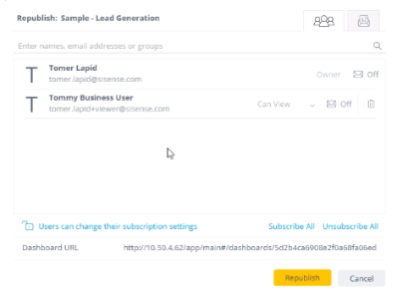
- Click Republish to republish the shared dashboard.
Important:
You must republish the shared dashboard for the updated settings to take effect.
To manage subscription settings as a Shared User:
-
In the heading of the your dashboard, click
 Email reporting settings. This button only appears only if the Dashboard Owner gave you the right to manage your reporting settings for this dashboard.
Email reporting settings. This button only appears only if the Dashboard Owner gave you the right to manage your reporting settings for this dashboard.Your subscription status appears in the top-right corner of the Report window. If you are unsubscribed to the dashboard report, you cannot change the schedule settings for the report. You can still manage your report content and receive a report on demand ("now").
-
Select the format in which you would like to receive the report, set the desired schedule, and then click Save.

- To unsubscribe from the report, toggle off the Subscription control at the top-right corner. Once
unsubscribed, only the dashboard owner can re-subscribe you.
Note:
If you were subscribed to the report both as an individual user and as part of a user group, once you unsubscribe from the individual account, the system will stop sending email reports to your email (ignoring the fact that you are still subscribed as part of the group).
Updating Dashboards
There are two ways to update a dashboard:
- Republish: A Dashboard Owner makes a change to the dashboard and republishes it so all Shared Users can see the changes.
- Restore: A Shared User restores a dashboard they changed locally to the state in which it was originally shared with them, without any modifications.
These two methods of updating dashboards are described in more detail, below.
Republishing Dashboards
When a Dashboard Owner modifies a dashboard it is not automatically updated for Shared Users. The owner of a dashboard must publish their dashboard, which updates the Shared Users' dashboards. However, for users with “Can Design“ permissions, while the filters are updated on republish, if they created a new widget it will not be deleted (widgets created by the dashboard owner are updated). Shared Users must refresh the shared dashboard before any of the Dashboard Owner's changes are applied.
When a dashboard that has been shared with at least one other user has pending changes that have not yet been published, Sisense highlights the Share icon as an indicator that until the dashboard is republished, the Shared Users do not have the latest dashboard.

To republish a dashboard:
- In the heading of your dashboard, click Republish.
OR
In the Dashboards list, right-click the dashboard's name and select >
Republish.
>
Republish.
Restoring a Shared Dashboard
Shared Users can modify shared dashboards by, say, changing filters. If required, Shared Users can remove all of their local modifications and restore these dashboards to the state in which they were shared.
To keep the modified shared dashboard, Shared Users with permission to Design over both the dashboard and the data model should save their modified shared dashboard as a new dashboard before restoring it.
To restore a shared dashboard:
- In the heading of the dashboard, click > Restore Dashboard.
OR
In the Dashboards list, right-click the dashboard's name and select > Restore Dashboard
> Restore Dashboard
- Confirm that you want to restore the shared dashboard.
Transferring Ownership of a Dashboard
A Dashboard Owner can transfer ownership of the dashboard to an Admin or another Designer. Transferring ownership of dashboards can be useful when, for example, the Dashboard Owner leaves the company and you do not want to lose their dashboards.
When you transfer ownership of your dashboard to another user, the dashboard remains as a shared dashboard within your Dashboards list, and you become a Shared User. As a Shared User, you are limited to how you can modify the dashboard.
If the Dashboard Co-Authoring feature is enabled, you can simply add a Co-Owner, and then delete the previous Owner.
If the Dashboard Co-Authoring feature is disabled, and you want to transfer ownership of a dashboard to someone else:
- In the heading of the relevant dashboard, click Share.
OR
For the relevant dashboard, in the Dashboards list, click > Share.
> Share.

- Enter the name of the Administrator or Designer to transfer ownership to.
- For the user you want to make an owner, select Make Owner.
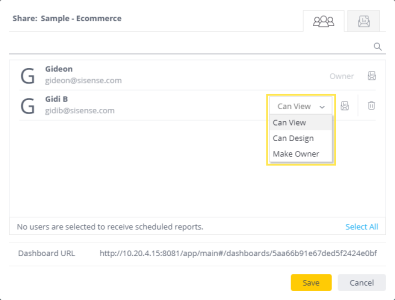
Note:
Changing the owner results in changing its position in the list of users such that the owner is listed first.
- Click Save.
- Click OK to confirm that you want to transfer ownership to the user.
Assigning Co-Ownership of a Dashboard
A Dashboard Owner can assign co-ownership of a dashboard to other users or groups (except the Everyone group). This can be useful when multiple users require the ability to make changes to a dashboard and publish it. For example, if different Designers own different parts of a dashboard, or to avoid potential bottlenecks when a single owner is unavailable.
In addition to any group Co-Owners, there must always be at least one individual user (not a viewer) Co-Owner. All Co-Owners have equal permissions (full access): editing, publishing, deleting other owners, changing shares, and even deleting the dashboard.
To transfer ownership, you can simply add a Co-Owner, and then delete the previous Owner.
The Dashboard Co-Authoring feature (co-ownership) is disabled by default. To enable it (as an Admin): click the Admin tab > Feature Management (under App Configuration) > turn on the Dashboard Co-Authoring toggle. When this feature is enabled, all published dashboards (existing and newly published) will have the co-ownership functionality enabled.
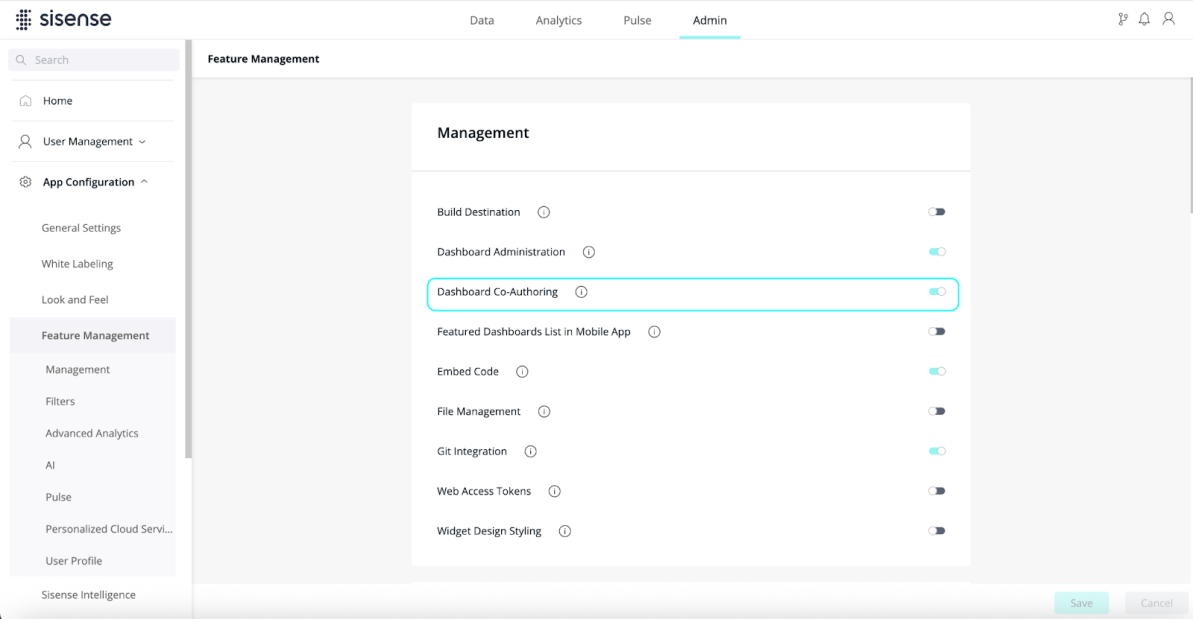
To assign co-ownership of a dashboard:
- In the heading of the relevant dashboard, click Share.
OR
For the relevant dashboard, in the Dashboards list, click > Share.
> Share.

- Enter the name of the user or group to assign co-ownership to.
Note:
If you assign co-ownership to a group which contains Viewer users, those users will retain only Viewer permissions. The Designers in the group will acquire Co-Owner permissions.
- For the user or group that you want to make a Co-Owner, select Make Co-Owner.
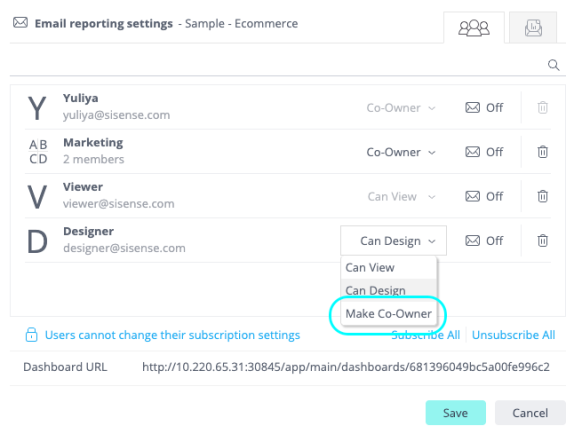
Note:
Changing the user role (Viewer/Designer/Co-Owner) results in changing its position in the list of users such that owners are listed first.
- Click Save.
- Click OK to confirm the new assignment of co-ownership.
Shared and Private Copies of Dashboards
Each Co-Owner (or the individual Owner, if there is a single Owner) gets access to 2 copies of a dashboard:
-
Shared copy - Created based on the original Owner’s copy. There is only one instance of this shared dashboard. This shared version can be accessed by all Co-Owners (one at a time). This dashboard is used for propagating the dashboard updates (when it is published) to all user copies of the dashboard.
-
Private copy - A separate private copy is available to each Co-Owner individually. This copy can be used for working with the dashboard privately as a consumer while the shared (“source”) version of the dashboard is being edited by one of the other Co-Owners. Changes made to the private copy do not affect the shared version or any other user’s copy. This copy is updated whenever the shared version is republished. However, for users with “Can Design“ permissions, while the filters are updated on republish, if they created a new widget it will not be deleted (widgets created by the dashboard owner are updated).
Note:
Shared and private copies are created whenever a dashboard is published, regardless of whether other co-owners or shared users were assigned to it.
Removing all users from a share does not ‘unpublish’ a dashboard. Therefore, shared and private copies are retained even for a single owner with no shares.
Editing Co-Owned Dashboards
To edit a co-owned dashboard, a co-owner can use the Private/Shared toggle to switch to the shared version. Only one co-owner can work with the shared version at a time. When a co-owner is editing the shared version, it is locked (and the toggle is disabled) for the other co-owners. The shared version is unlocked whenever the co-owner switches to their private version (using the toggle), to another application page, logs out, or when a 4 hour timeout is reached.
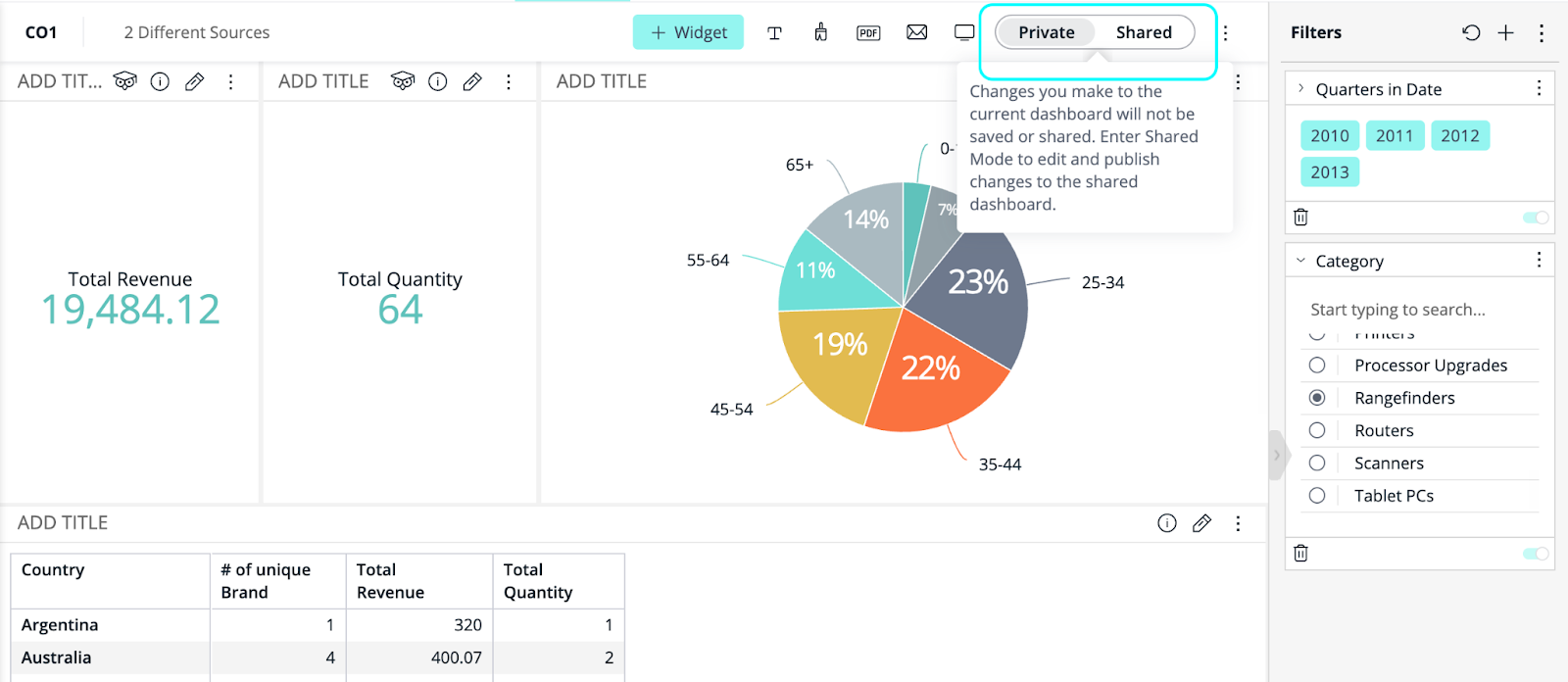
Co-owners are notified about a shared version’s locked/unlocked status when they open a dashboard, when refreshing the page, or when trying to enter shared mode. Real-time notifications are not yet supported.
Administrators can unlock any locked dashboards and update the dashboard shares (for example, to add more co-owners or to add themselves as co-owners). To unlock a locked dashboard, open it in the Administrator view:
-
In the Analytics tab, click All Dashboards.
-
Locate the dashboard and open it:
-
For dashboards not shared with or co-owned by the administrator, click the dashboard to open it.

-
For dashboards shared with or co-owned by the administrator:
-
From the dashboard 3-dots menu, select Switch to Administrator View (displayed in the first image below). If it is co-owned by the administrator, this is located in the Shared menu (displayed in the second image below).
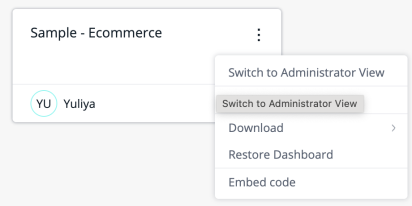

-
In the Administrator View, click the
 icon to unlock the dashboard.
icon to unlock the dashboard.
-
-
Dashboard Actions
Many of the dashboard actions, such as duplicate, export, download, and so on, can be triggered for each dashboard copy (private and shared) separately. Some actions are only available for the shared version: rename, republish, and delete.
This is reflected in the dashboard menu in the navigation panel, or from the Analytics page tile:
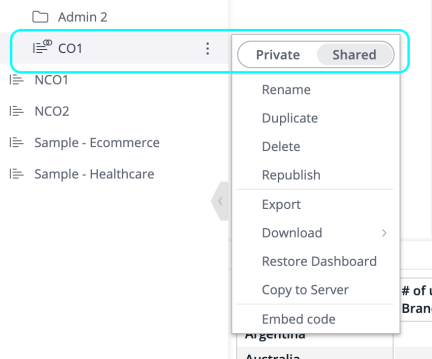
Changing the Data Source
Co-owners can change the data source for the shared copy. Co-owners and Designers can change the data source for their private copies. After republishing, the data source(s) are updated for all private copies (including co-owners' private copies) according to the shared copy data source(s). Widgets created by users in their private copies keep the original data source.
Pulse Alerts
Co-owners can create Data alerts independently from both shared and private copies of the dashboard. For more information, see Creating Data Alerts.
API Parameters
-
Use
sharedMode=truefor working with the shared version of a co-authored dashboard. -
If no parameter is provided, the request will be performed for the private copy (
sharedMode=falseis ignored). -
The
sharedMode=trueparameter is NOT used in the following APIs: share/publish, lock, unlock, change_owner. These actions are only performed for the shared version.
Limitations
-
Git integration is not supported for co-authored dashboards.
-
Dragging-and-dropping widgets from one dashboard to a shared copy of another dashboard is not supported; the copied widget will be private (not shared).
-
Notebooks C2D is not supported for co-authored dashboards.
Disabling the Feature
When the Dashboard Co-Authoring toggle is disabled, the shared copies of dashboards are deleted. For each dashboard, its remaining owner retains their private copy which now becomes the owner copy. Any unpublished changes from the dashboard shared modes will be lost. In order to keep the changes, the shared dashboards must be republished before turning the feature off.
When the feature is re-enabled, the shared copy for published dashboards is created from the current owner copy.
Stop Sharing a Dashboard
You can stop sharing a dashboard that you have previously shared with other users.
To stop sharing a dashboard:
- In the heading of your dashboard, click Share
 .
. - Delete all of the email addresses and groups from the list of Shared Users.
- Click Save.